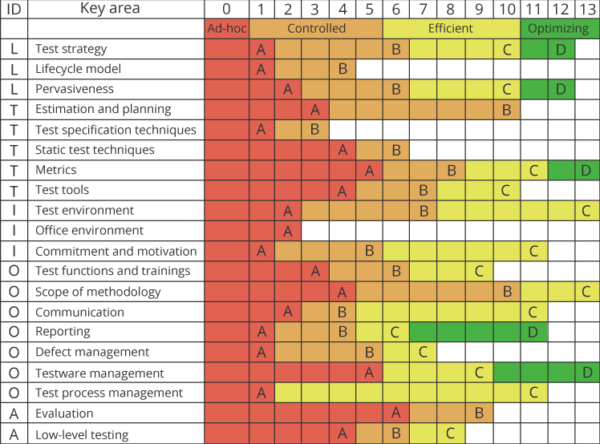
Maturing Your Quality Assurance Process for Enhanced Testing

Quality assurance (QA) processes are crucial to creating software that meets the standards of quality and meets the needs of users. Quality assurance involves processes that ensure the success of software before it is released. With quality properly monitored and maintained, customer expectations of high quality, reliability, and scalability can be met. However, many companies are not mature enough to meet the needs of new-age customers and thus fail to keep pace with the advances. With mature QA processes, many of these challenges can be resolved, and the highest quality product can be delivered fast.
This article will help you identify the maturity level of your QA processes as well as make suggestions on how to advance your QA maturity to meet the pressing demands of modern enterprises. The following topics will be explored:
- What is quality assurance
- TMMi model of QA maturity
- TPI model of QA maturity
- How to move up on the levels of maturity
The Necessity of Quality Assurance
75% of software projects face budget overruns. This is what can happen if your QA processes are ad-hoc and don’t follow quality guidelines. Even if you have some QA processes defined and repeatedly used, you can still suffer from 25-50% of budget overrun cases. It is only when you have consistent processes of quality assurance and have achieved an effective level of maturity that you can expect to start savings. And with the maturity of your process, you get more benefits like prevention of defects, clarity of client requirements, and efficiency in test processing. But how do we know where we stand on the ladder of QA maturity?
The Models of Maturity
The two most common models that guide the understanding of QA maturity in software development are Test Maturity Model Integration (TMMi) and Test Process Improvement (TPI). The TMMi model is mostly used by large enterprises as it requires significant investments for implementation, unlike TPI which has easy guidelines and can help small vendors with self-assessments.
TMMi Model: This model identifies 5 levels of QA maturity:
- Initial
- Managed
- Defined
- Measured
- Optimized
Level 1: An organization begins with the initial stage in which everything is unstructured and managed using ad-hoc processes. The focus is on delivering products and testing is limited to debugging. Certain repeatable procedures are established and documented. A company at this level would run multiple tests including smoke tests, regression tests, integration tests, and user acceptance tests in the later stages of software development.
Level 2, or the managed stage of maturity, an organization, follows established test procedures and has policies to direct monitoring, control, test design, and test execution. The test environment is in place.
Level 3, or the defined stage, of maturity is marked by the documentation of processes, creation of a knowledge base, and implementation of best practices. Testing begins with requirement gathering and the testing approaches used are specific to project requirements.
Level 4 is measured maturity which means process outputs are also measured. This helps establish an understanding of the quality, stability, and reliability of the software developed to bring continuous improvements in the future. Reviews and inspections are regular, and the aim of the QA team is to ensure the effectiveness of testing procedures.
The highest level of maturity is an optimized stage. Processes are attuned to industry best practices and the practicing organization can speed up testing, time-to-market, and reduce costs without making any compromises on quality. Defects are not just corrected upon evaluation, but preventive measures are taken at the early stages of development to avoid them from occurring in software.
TPI Model: Similar to the TMMi model, this model identifies scales of maturity including controlled, efficient, and advanced. Ad-hoc processes are not considered as mature and thus, not measured in this model. It begins with controlled processes that are marked by the presence of testing strategies, lifecycle model of development, defect management, reporting structures, and test process management. At the next level, control is obtained by adding static techniques for testing, metrics for measurement, creation of attest environment, testware management, and evaluation. The advanced level follows matured metrices, test functions, testware management, and have pervasiveness.

Source: ScienceSoft
The TPI model categorizes test processes into 16 areas as shown in the table above with each offering different scales of maturity. Based on the scale at which an organization operates, it can avail benefits like efficiency, effectiveness, quality improvement, enhanced compliance, cost reduction, and improved value of software quality. The assessments obtained through TPI evaluation can be compared with industry benchmarks.
Once an organization knows where it stands on the quality ground compared to other companies in the industry, an improvement roadmap would follow guiding the organization with recommendations for improvements in the categorized areas. For instance, a company ranking low on test management compared to industry benchmarks could be recommended migration of manual test cases. A company low on test estimation might be suggested to take a different approach to estimation.
Moving Up the Maturity Levels
To level up the model of maturity, you need to first analyze your processes to discover what level you are at. Then, you can find gaps to fill to go a notch up.
At level 1, your processes are not systematized. Identify repeatable processes, define them, and create rules to reuse to set up a basic project management structure to move to the next level 2.
At level 2, your basic processes are defined but your staff may not be trained to use them effectively. Standardize processes for them, create documentation, and integrate people to follow procedures to move to the next level 3.
At level 3, you have documentation in place and some training, but the outcomes or improvements that standardization has brought you are not clear. To move to level 4, quantify your processes by diving tasks into components, and identifying efforts and resources required to make their inputs and outputs measurable. Measurement allows you to collect data that you can also use to make predictions of performance and find ways to keep enhancing it.
At level 4, your processes are well-managed and accurately measured. To reach the pinnacle of QA maturity level 5, bring innovation to the center of your stage, employ continuous improvement as the philosophy and incorporate tools and technologies that advance your systems and processes.
Quality Maturity Assessment at Apexon
Apexon follows a five-step maturity model that aligns the stages of standard maturity models with different areas in the quality assurance landscape. The benefit of this model is that it offers you marks of maturity in the areas of processes, automation, infrastructure, testing, and test environment. Let’s explore how this model can help you identify your level of maturity:
You are at the base level of QA maturity if:
- You are using conventional QA methodologies
- You are using manual methods of testing
- Your teams are struggling with bottlenecks because of infrastructure limitations
- You use a dedicated test environment for testing with limited automation for builds
- Your team is fraught with test data issues that cause automation failures
You are at the beginner level of QA maturity if:
- You have grown beyond traditional methodology and have adopted hybrid methods
- You are performing functional and GUI-based testing, but coverage is limited
- Your teams are better off with basic visualization in test technology but there still are some tailbacks
- You are using CI tools for triggering builds and anonymize production data in a test environment
- Your test scripts are data driven but incorrect test data is still causing failures
You are at an intermediate level of QA maturity if:
- You are using Agile processes and detecting defects in the early stages of software development
- Your coverage of GUI-based testing has improved significantly, and you have achieved some level of test automation
- You have created a fully virtual test infrastructure and have no dependency on physical infrastructure
- You are using CI tools for automatic triggering of builds
- Your test data strategy has evolved, and you are leveraging service virtualization for test automation
You are at the advanced level of QA maturity if:
- You are following iterative development and your teams have a unified view of QA
- Your coverage of test automation is comprehensive and allows parallel testing
- You are leveraging on cloud-based on-demand infrastructure for the test environment
- Your CI pipeline has fully automated acceptance tests
- Your test data operation is fully automated
You are at the highest level of maturity and can call your team an expert in QA if:
- Your cross-functional team has a real-time dashboard that performs quality health checks
- You have implemented automation at different levels and integrated it with CI/CD pipeline
- Your team leverages containers and cloud to set up, tear down, or scale up nodes for testing
- You have integrated quality gates for unit tests, acceptance tests, code quality, and coverage
- Your team uses advanced tools for virtualization service and machine learning for automation
More on Test Automation
Automation testing is the hallmark of QA maturity. While your organization could still be using certain manual testing methods, adopting automation will bring you powerful results. A wide number of testing processes are now possible to automate to improve effectiveness, reduce errors, enhance efficiency, reduce cost, allow easy scaling, and bring results faster. These include regression testing, smoke testing, performance testing, and functional testing. Some testing procedures might not be wise to automate because of the importance of human involvement such as user experience testing and accessibility testing.
However, automation can bring down resource expenses by eliminating manual work that could consume time and add costs. Here are a few examples of how test automation can improve QA testing outcomes:
- With automation, an insurance organization can save on the manual efforts that go into fixing data errors like null and NaN values in claims data
- Regression testing can put time constraints on a project and delay a release as thorough testing can be very time-consuming. Adding automation to regression testing can cut the time for testing to less than half
- An eCommerce firm could be smoke testing for searches, cart additions, check-outs, and order placements. Automating each of these testing paths can make testing easier and faster by organizing test suites, running them, and understanding test failure results.
- Manual checking of the performance of an application can be stressful for developers. Automating performance testing can release it and improve test efficiency at the same time
In addition to saving time and effort, test automation can offer the following benefits:
- Test coverage is improved
- Bugs can be detected and eliminated in earlier stages of development
- Testing can be performed on multiple platforms simultaneously
- Reusable test functions, scripts, and cases can ease the testing burden
- Clear reports allow quick analysis of test cases
- Bug-free builds can be released in less time
- Automation makes the system scalable as additional resources might not be required for the changes in test procedures
Maturing Your Quality Assurance Process
A stable version of high-quality software delivered within weeks—is that not what every customer demands from a team of developers? However, developments cannot happen at the drop of a hat, at least not high-quality ones. But if fast launches are prioritized, development initiatives cannot run without trade-offs unless the quality assurance processes of an organization are mature enough to handle the pressures. Achieving an effective level of QA maturity and introducing test automation is your ticket to high quality product releases in less time and with less risk.
Apexon uses test automation with Agile and DevOps to bring better results from QA than traditional testing procedures such as enhanced quality, faster time-to-value, and better customer experience. To know more, check out Apexon’s quality engineering servicesor fill out the form below.




